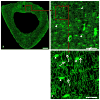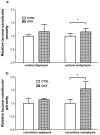Alterations in the osteocyte lacunar-canalicular microenvironment due to estrogen deficiency
- PMID: 22634177
- PMCID: PMC3412941
- DOI: 10.1016/j.bone.2012.05.014
Alterations in the osteocyte lacunar-canalicular microenvironment due to estrogen deficiency
Abstract
While reduced estrogen levels have been shown to increase bone turnover and induce bone loss, there has been little analysis of the effects of diminished estrogen levels on the lacunar-canalicular porosity that houses the osteocytes. Alterations in the osteocyte lacunar-canalicular microenvironment may affect the osteocyte's ability to sense and translate mechanical signals, possibly contributing to bone degradation during osteoporosis. To investigate whether reduced estrogen levels affect the osteocyte microenvironment, this study used high-resolution microscopy techniques to assess the lacunar-canalicular microstructure in the rat ovariectomy (OVX) model of postmenopausal osteoporosis. Confocal microscopy analyses indicated that OVX rats had a larger effective lacunar-canalicular porosity surrounding osteocytes in both cortical and cancellous bone from the proximal tibial metaphysis, with little change in cortical bone from the diaphysis or cancellous bone from the epiphysis. The increase in the effective lacunar-canalicular porosity in the tibial metaphysis was not due to changes in osteocyte lacunar density, lacunar size, or the number of canaliculi per lacuna. Instead, the effective canalicular size measured using a small molecular weight tracer was larger in OVX rats compared to controls. Further analysis using scanning and transmission electron microscopy demonstrated that the larger effective canalicular size in the estrogen-deficient state was due to nanostructural matrix-mineral level differences like loose collagen surrounding osteocyte canaliculi. These matrix-mineral differences were also found in osteocyte lacunae in OVX, but the small surface changes did not significantly increase the effective lacunar size. The alterations in the lacunar-canalicular surface mineral or matrix environment appear to make OVX bone tissue more permeable to small molecules, potentially altering interstitial fluid flow around osteocytes during mechanical loading.
Copyright © 2012 Elsevier Inc. All rights reserved.
Figures








References
Publication types
MeSH terms
Substances
Grants and funding
LinkOut - more resources
Full Text Sources

